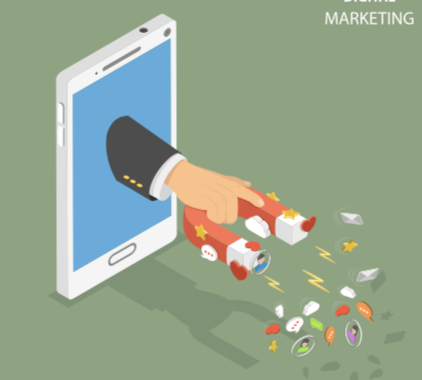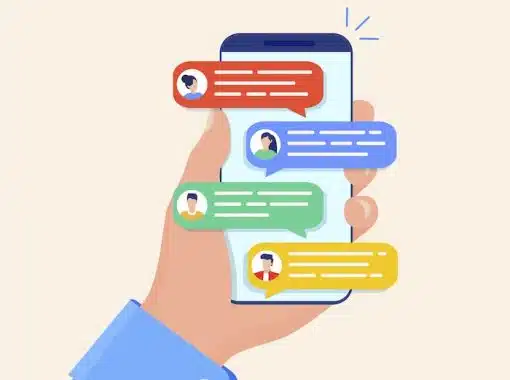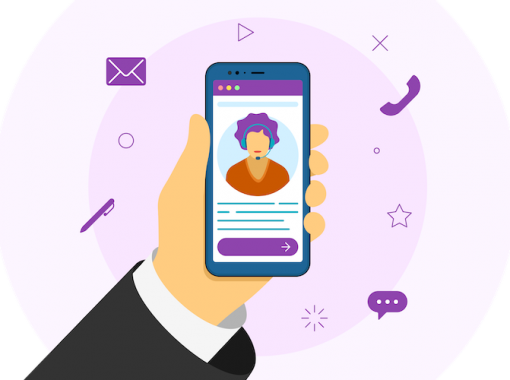
A study by Accenture found that 91% of consumers are more likely to shop with brands that provide personalized and relevant offers and recommendations.
As more companies adopt personalized marketing efforts, customers come to expect it from other brands as well. From in-store discounts to online recommendations, shoppers prefer to patron and remain loyal to businesses that tailor the overall experience to their needs.
However, it’s not enough to add a customer’s name to an email and call it a personalized marketing strategy. Instead, brands need to dig deep and identify specific areas and tactics where personalization opportunities can be leveraged.
We’ll show you how!
What is Personalized Marketing?
Personalized marketing, also referred to as 1:1 marketing or marketing personalization, is a marketing strategy that uses customer data to deliver specific messages, content, and digital experiences to an individual.
Have you ever been browsing products online, only to see them appear in a banner or social media ad later? This is one type of personalized marketing tactic.
There are six different types of commonly used marketing personalization applications:
- Segmentation of target audiences
- Personalization for individual shoppers or buyer personas
- Delivering the right message to the right person using content filtering tactics
- Recommendation programs which suggest related or commonly purchased items at checkout
- Collaborative filtering used by recommender systems
- Customer journey mapping and optimization
Why Do Brands Use Marketing Personalization?
Marketers are turning to personalized marketing tactics as old-fashioned strategies such as cold-calling, print materials, and mass emails no longer do the trick. Customers today understand and recognize sales tactics. So, why not give your leads and clients marketing experiences designed solely for them?
Plus, more customer data is available to brands than ever before. From previous website activity to shopping habits, brands have a wealth of data at their fingertips.
Through this access to data, brands can:
- Make strategic decisions and deliver personalized messages to improve online conversion rates.
- Provide customers with a seamless shopping experience through product recommendations and personalized content.
- Connect with followers, potential leads, and current customers on a deeper level by understanding the needs of each individual and their position in the buyer’s journey.
- Effectively target specific audiences rather than a “one size fits all” promotional approach.
Why Do Customers Enjoy Personalized Marketing?
There is nothing more frustrating than spending your precious time searching all over the internet or a website for a product or piece of information. Personalized marketing alleviates that aggravation by providing recommendations for products, content, and so much more.
And, through personalized marketing tactics, customers feel more connected to their favorite brands. SmarterHQ reported that brand loyalty among millennials increases by 28% if personalized communications are delivered.
5 Ways to Personalize Your Current Marketing Tactics
While you can overhaul an entire strategy to focus on marketing personalization using customer data, it’s best to start small and successfully build on techniques that work.
Begin your marketing personalization efforts with these five tactics.
1. Email Marketing
Remember, at the end of the day, email marketing messages are essentially digital letters delivered directly to your customer’s mailbox.
Do you want to be the brand that constantly sends spam? Or the brand that sends thoughtful, relevant messages based on the customer’s needs?
(Choose the latter!)
Email marketing is an excellent way to begin implementing personalization into your marketing strategy. You can start simple and work your way up by:
Including the Recipient’s Name in Emails
This is the easiest personalization tactic available to marketers. Including the customer’s name in the subject line and as part of the main message is a fantastic way to connect with customers and show them you care.
Sending Product Recommendation Emails and Shopping Guides
Using marketing automation software, marketers can send personalized emails to customers filled with relevant product recommendations and shopping guides. These products are suggested based on the customer’s shopping history and past activity on the brand’s website.
Sharing Relevant Content in Newsletters
The key to successful email marketing and personalization is list segmentation.
Your email marketing subscribers all have different needs, desires, and goals when it comes to interacting with your brand. Segment these interests and needs into various lists. Use these lists to send relevant content based on the individuals’:
- Position in the buyer’s journey.
- Previous website activity and interactions.
- Geographic location.
- Past purchases.
From interesting articles about the product they just purchased to “How-to” videos for new leads, the personalization possibilities are endless.
2. Social Media
Similar to traditional marketing, social media was once a place where brands plastered a picture/link and caption on their feed for all to see.
However, with mind-blowing targeting capabilities and new features, brands can individualize their messages and content on social media networks.
Respond to Customer Messages
Starting a social media personalization strategy is as simple as responding to customer comments and direct messages. This one-to-one conversation is a great way to ascertain a customer’s needs or interests. Use that information to tailor your social strategy moving forward.
Use Customer Data to Guide Targeted Ads
While you won’t be able to personalize social media ads using the individual’s name (that’d be taking personalization a bit too far!), you can target social media ad campaigns with data such as:
- Geographic location.
- Demographic information.
- Social media activity.
- Shopping preferences.
- Hobbies and interests.
- Income.
And that’s only scratching the surface.
Use these intricate targeting features to develop and distribute highly segmented social media ad campaigns for specific customer personas.
For instance, a car dealership can create social media ads targeting users who’ve searched for a Ford Focus in Nashville, Tenn., and are interested in the Tennessee Titans. Using this information, they can also craft their ad creative to match those customer interests!
3. Content Marketing
Today, content marketing is the cornerstone of a brand’s online marketing strategy. From informative blog posts to entertaining videos, these pieces of content work to attract the attention of potential leads and retain existing customers.
Fortunately, much of this strategy can be personalized, too.
Suggest Content Based on Activity
Let’s imagine a user reads an article about video production. Throughout the article, there are callouts to related articles on video editing, video distribution, and other similar topics. And, at the bottom of the post, there’s a banner encouraging them to click over to another related article to continue learning about video production.
This tactic of suggesting content based on a user’s activity is a basic approach to marketing personalization. Marketers can take this to the next level by utilizing cookies and other tracking software to manipulate their website to show blog post topics relevant to the user’s activity during their previous website visit.
Persona-Focused Content
Back to the video production article example …
A beginner videographer and an expert won’t want to read the same article. And, they’re both at different points in the buying cycle. A beginner is in the process of absorbing the basics and as much information as possible, while an expert is looking for the nitty-gritty details or an exact answer.
With this concept in mind, marketers can create persona-focused content for every segment of their audience. Although the content is not personalized to the individual, it will satisfy their needs and convince them to return for more content.
4. eCommerce Stores
A 2018 Epsilon survey reported that 80% of consumers are more likely to buy from an online store that offers personalized experiences.
Since online stores can’t offer in-person experiences like talking with a sales representative, they have to resort to other personalization tactics.
Product Recommendations
In the SmarterHQ Amazon Report, it was discovered that 47% of shoppers will turn to Amazon if the online store they’re shopping on doesn’t offer relevant product suggestions. For a small or local business, this is a major segment of their potential customers!
Product suggestions can be implemented as “Frequently Bought Together” recommendations for top products or individualized recommendations generated from customer shopping history.
For instance, a customer who previously purchased a mixer for baking from a kitchenware website would receive relevant product suggestions like various ingredients, baking tools, and accessories for the mixer — based on that past purchase.
Retargeting Ads
Marketing personalization can be implemented to influence an eCommerce store conversion, too.
If a user visits a website, looks at a few products, and leaves without making a purchase, brands can execute a retargeting ad campaign. These ads are based on the user’s website and shopping activity and work to bring them back to the website to complete their purchase.
This concept works excellently in tandem with abandoned cart emails to improve an eCommerce brand’s overall conversion rate.
5. Website Personalization
Websites are the hub for marketing personalization. Companies can leverage a myriad of personalization strategies throughout their site to customize the experience for new visitors and returning customers.
Personalized Landing Pages
Landing pages are a critical component of any inbound marketing campaign. Why not take the extra step and personalize these landing pages for each lead?
For instance, if a lead clicks the link to a landing page from a sales email, they’ll be directed to a page automatically customized to their needs and interests.
Chatbots
Chatbots are an excellent way to leverage marketing personalization. Website visitors can chat with the artificial intelligence bot that will direct them to the information or product they want.
Chatbots are also capable of:
- Recommending specific products and content based on user interactions.
- Signing customers up for an email newsletter.
- Assisting customers with the purchase process.
- Following up during a return visit.
Marketing Automation
Marketing automation software is the centerpiece of every successful personalized marketing strategy. This tool automatically executes a series of programmed events based on a user’s information and activity.
For example, if a website visitor signs up for a brand’s email newsletter, the software then knows to send a series of individualized emails about specific topics at predetermined intervals. Or, if a user downloads a free guide or piece of content, this can also serve as a personalized marketing automation trigger.
Always Track Your Personalized Marketing Leads
Marketing personalization isn’t a trend. It’s the new normal for brands looking to retain customers in the long-term, improve conversion rates, and increase overall brand awareness.
But, tracking the online leads generated from a personalized marketing strategy is only half of the picture. Have you considered the leads who decided to call your company after interacting with a personalized email or ad?
Call-tracking numbers can be integrated into every type of personalized marketing effort, from retargeting ads to emails and text message marketing campaigns.
When a lead calls this specific phone number, you’ll know exactly which marketing personalization tactic brought them there.
Sign up for your toll-free numbers with call-tracking features and start personalizing your marketing tactics today!












